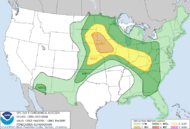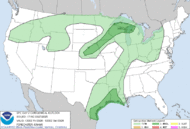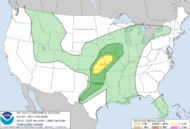Awareness Week |
Local SKYWARN |
NM Hazards |
Weather Safety |
Thunderstorms |
Tornadoes |
Lightning |
Storm Report |
 |
||
|
Severe thunderstorms are defined by the National Weather Service as downdraft winds in excess of 58 miles an hour and/or hail 1 inch in diameter or greater. Severe thunderstorms are reported each year in all New Mexico counties, but they typically peak in the east during April through June and statewide July through August.
The Storm Prediction Center in Norman, Oklahoma issues a SEVERE THUNDERSTORM WATCH to give you advance notice that severe thunderstorms are possible in your area. This gives you time to make preliminary plans for moving to a safe location if a severe thunderstorm warning is issued. The SPC also issues thunderstorm (convective) outlooks as seen below for days 1 through 3.
|
||
 |
 |
 |
|
A SEVERE THUNDERSTORM WARNING is an urgent announcement that a severe thunderstorm has been reported or is imminent and warns you to take cover. Severe thunderstorm warnings are issued by local National Weather Service offices.
What you can do before a storm strikes...
When thunderstorms approach... Outdoors:
Indoors:
|
||